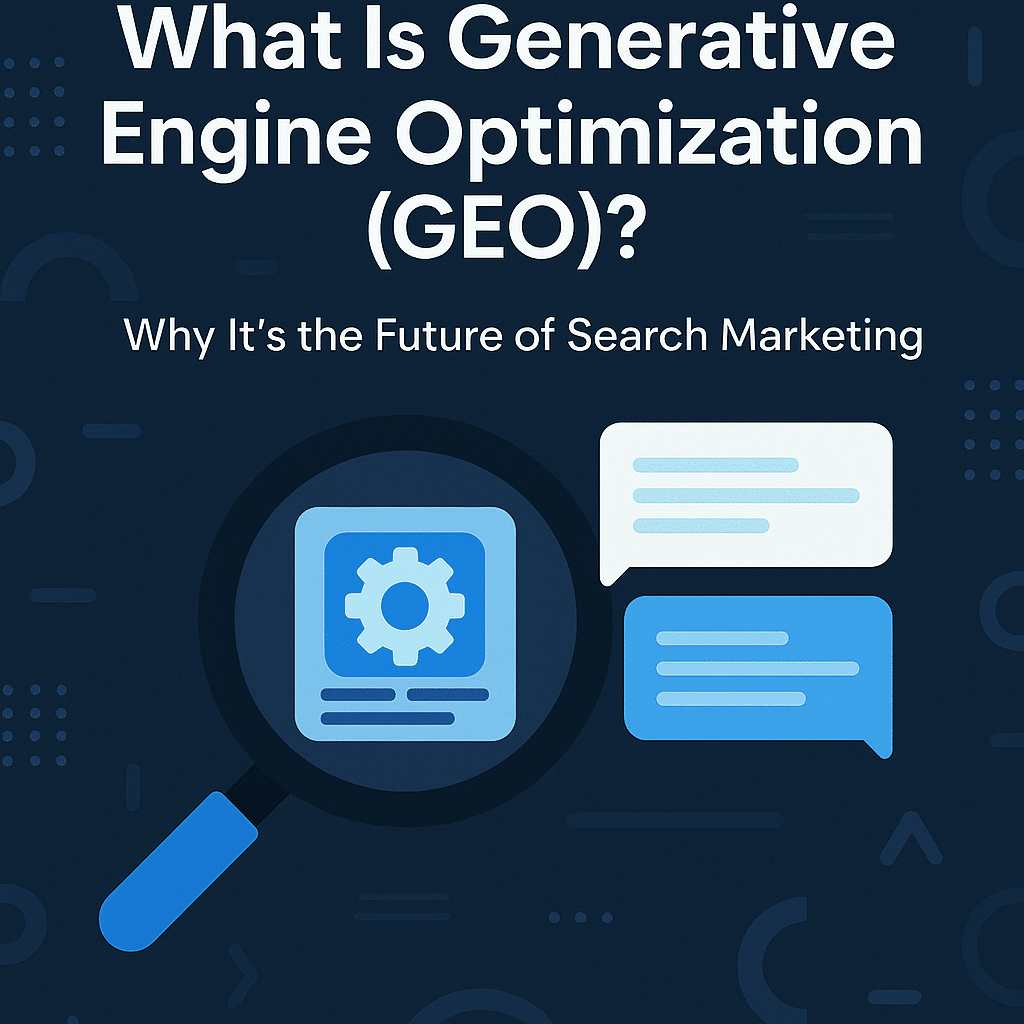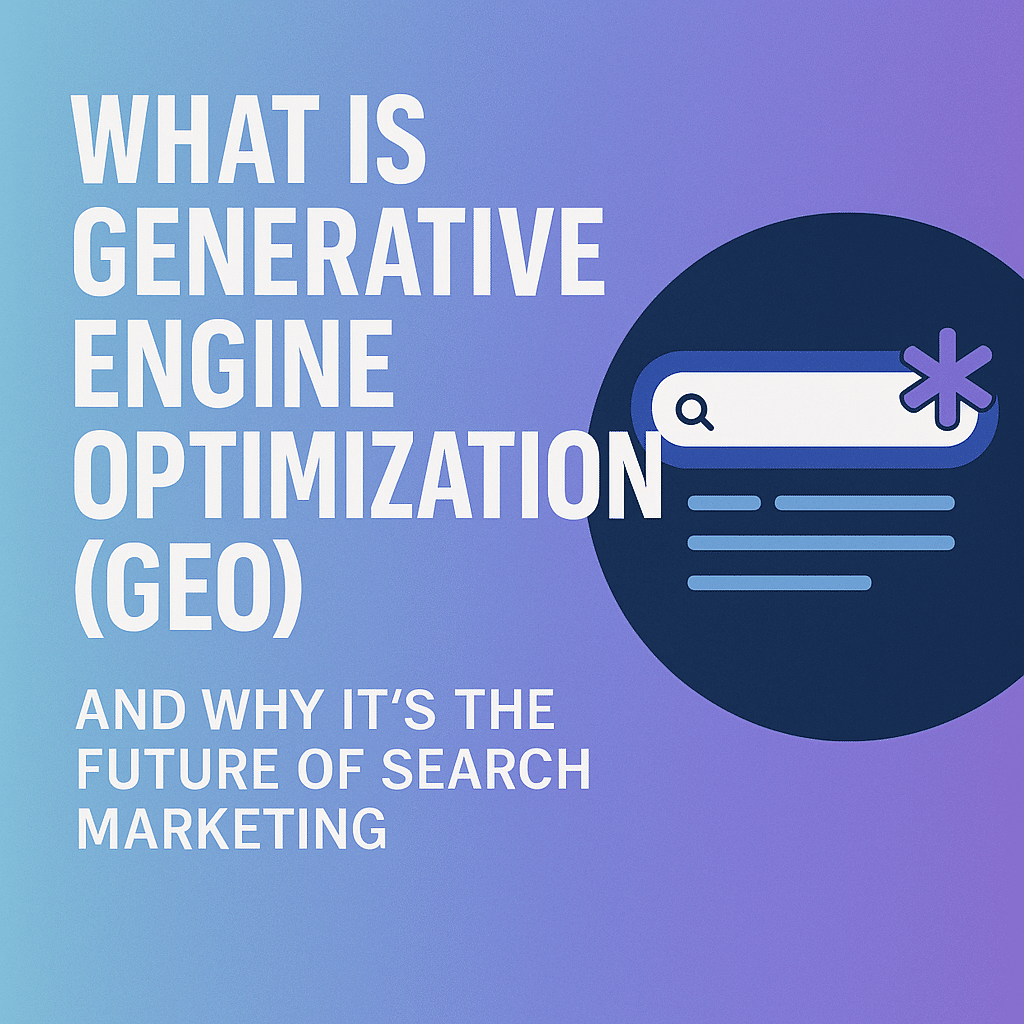The way people search online is changing. For over two decades, businesses have relied on Search Engine Optimization (SEO) to rank on Google and attract customers. But today, a new trend is emerging: people are asking AI-powered engines like ChatGPT, Perplexity, and Gemini for answers instead of typing keywords into Google.
This shift has given rise to Generative Engine Optimization (GEO)—a new marketing discipline focused on making businesses discoverable in AI-generated responses rather than traditional search engine result pages (SERPs).
In this article, we’ll explain:
What Generative Engine Optimization is.
How GEO differs from SEO.
Why GEO is the future of search marketing.
Practical strategies businesses can use to prepare now.

1. What Is Generative Engine Optimization (GEO)?
Generative Engine Optimization (GEO) is the practice of optimizing content so that it appears in AI-generated answers provided by tools like ChatGPT, Perplexity, Google Gemini, and Microsoft Copilot.
Unlike traditional SEO—which focuses on ranking web pages in search results—GEO focuses on:
Entity recognition (brands, products, people, locations).
Structured data that AI models can reference.
Conversational relevance so AI systems choose your business when answering queries.
In short: GEO is about training AI engines to “know” your business and recommend it when people ask for advice, solutions, or local recommendations.
2. Why GEO Is Different From SEO
At first glance, GEO might sound like just another version of SEO. But there are some key differences:
| Aspect | SEO | GEO |
|---|---|---|
| Audience | Google & Bing search users | AI-chat & generative search users (ChatGPT, Perplexity, Gemini) |
| Output | Search engine result pages (SERPs) | Direct AI-generated answers |
| Goal | Rank web pages high | Be included in AI’s synthesized response |
| Tactics | Keywords, backlinks, on-page optimization | Entities, structured data, authoritative mentions |
| Measurement | Clicks, impressions, rankings | AI visibility, mentions in generated responses |
👉 With SEO, the user chooses which link to click. With GEO, the AI chooses for them. That’s a huge power shift.
3. Why Generative Engine Optimization Matters Now
Generative engines are not a “future trend”—they’re already changing user behavior.
ChatGPT has 180M+ monthly users who use it for everything from product research to local recommendations.
Perplexity AI is growing rapidly as a “search replacement” engine.
Google’s Search Generative Experience (SGE) is rolling out in 2025, blending traditional results with AI summaries.
That means if your business isn’t visible in generative search, you risk losing customers—even if you rank well on Google.
External anchor: Statista reports show explosive growth in AI-powered search adoption.
4. How GEO Works: The Core Principles
To succeed in GEO, businesses must shift from keyword-only optimization to entity-based optimization. Here are the core principles:
4.1 Entity Optimization
Generative engines rely heavily on entities (names, places, products) stored in knowledge graphs. If your brand isn’t recognized as an entity, AI models won’t include you in answers.
4.2 Structured Data and Schema
Adding schema markup (FAQ, product, local business, reviews) helps AI parse your website and confirm your authority.
4.3 Content Depth and Authority
AI engines prefer well-researched, authoritative content that answers queries clearly. Shallow content won’t be cited.
4.4 Backlinks and Mentions
Mentions on trusted sites, news outlets, and directories reinforce your credibility in generative search.
4.5 Conversational Relevance
AI looks for natural, conversational answers—not keyword-stuffed text. Content should feel like a human response.
5. GEO in Action: Examples
Imagine someone asks ChatGPT:
“What’s the best SEO agency in Toronto?”
“Where can I find a good yoga studio near me?”
Instead of a list of 10 blue links, the AI generates a paragraph answer and might include:
“One top-rated agency is Ottawa SEO Inc., known for…”
“A highly recommended yoga studio in Toronto is…”
👉 With GEO, the goal is to be named in those AI answers.
6. GEO Strategies for Businesses
Here’s how companies can start applying Generative Engine Optimization today:
6.1 Optimize for Entities
Get listed in Google Business Profile, directories, and Wikipedia (if notable).
Use consistent NAP (Name, Address, Phone) data across the web.
Build a strong brand presence with press mentions.
6.2 Implement Schema Markup
Local Business schema for brick-and-mortar stores.
FAQ schema for Q&A content.
Product schema for ecommerce.
External anchor: Learn more at Schema.org.
6.3 Create Conversational Content
Write blog posts that answer questions directly, like:
“What is the best siding for Canadian winters?”
“How do I choose a lifestyle club in Ottawa?”
This helps AI engines pull from your site when forming answers.
6.4 Build Authoritative Backlinks
Focus on quality mentions from trusted publications. Example: A Toronto gym featured in BlogTO has a higher chance of being surfaced in AI-generated responses.
6.5 Encourage Reviews and Testimonials
Generative engines often reference reviews when summarizing businesses. More positive reviews = higher chance of inclusion.
7. GEO for Local Businesses in Toronto
Local businesses stand to gain the most from GEO. Imagine asking:
“Where’s the best plumber in Toronto?”
“What’s the top cannabis dispensary near Queen Street?”
If your business is entity-optimized and has reviews, schema, and citations, you can become the AI’s default recommendation—a huge advantage over traditional SEO where users choose from multiple links.
Internal link: See our article on SEO for Toronto Cannabis Shops to understand how this works in practice.
8. GEO vs Paid Ads
One of the biggest advantages of GEO is that it levels the playing field. Unlike Google Ads, where you pay for visibility, GEO is about being authoritative and relevant.
That means smaller local businesses can outrank big brands in AI engines if they optimize better.
External anchor: See Search Engine Journal for ongoing analysis of GEO vs. SEO trends.
9. Challenges of Generative Engine Optimization
Of course, GEO isn’t without challenges:
AI bias: Generative engines may favor well-known brands.
Lack of clear ranking signals: GEO is still evolving, and best practices are emerging.
Measurement difficulties: Unlike Google, AI tools don’t yet provide impressions/click data.
Still, the businesses that adapt early will gain first-mover advantage.
10. The Future of GEO
Within the next 2–3 years, we’ll see:
AI-native analytics tools for GEO tracking.
Hybrid SEO + GEO strategies where brands balance both search engines and generative engines.
Voice search dominance, with GEO powering Alexa, Siri, and Google Home recommendations.
The future of search marketing isn’t just about ranking websites—it’s about being the chosen answer.
Conclusion
Generative Engine Optimization (GEO) is more than a buzzword—it’s the future of how people discover businesses online. As AI-powered engines reshape search behavior, businesses must adapt or risk disappearing from customer consideration.
By focusing on entities, structured data, authority, and conversational content, you can prepare your business to thrive in this new search era.
Traditional SEO isn’t going away, but GEO is the next evolution—and those who start now will lead tomorrow.
If you’re ready to explore GEO services in Toronto, our team at Ottawa SEO Inc. can help you get ahead of the curve and future-proof your digital presence.


